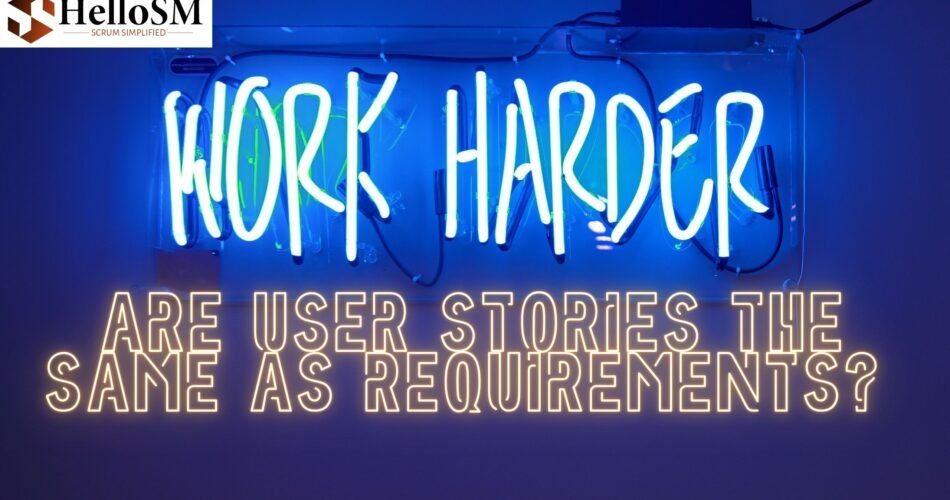If you’ve ever sat in a Scrum or Agile workshop, you’ve probably heard the question:
“Are user stories the same as requirements?” And if you’ve attended any of the HelloSM webinars (yep, one of the best Scrum training institutes in India), you already know this question pops up every single time. So let’s unpack this, without the jargon, and with a touch of how real teams actually experience it.
User Stories vs. Requirements – What’s the Real Difference?
User stories aren’t exactly “requirements.” They’re more like conversation starters. Think of them as friendly reminders that tell your team: “Hey, we need to talk about this feature.” Each story is a placeholder, a promise to discuss what’s needed, why it’s needed, and how it’ll add value to the user. So instead of treating a story as a detailed instruction manual, think of it as a pointer to the requirement, something that sparks collaboration. A good user story might later lead to a UI sketch, a sample dataset, or even a flow diagram. But in its purest form, it’s intentionally short and human. That’s the magic of user stories. They keep the conversation alive, instead of freezing it in documents no one ever reads again.
Who Writes Acceptance Criteria for User Stories?
This one’s another favorite question. The simple answer? The Product Owner. Since the Product Owner is the one who decides whether a story meets expectations or not, they’re also responsible for writing the acceptance criteria (or conditions of satisfaction). But here’s the twist: acceptance criteria aren’t long test cases. They’re like a table of contents — a quick reference for what’s critical to make this story “done.” Example: The list should sort by any column header clicked. The first click sorts ascending, the next descending.
If the Product Owner feels the product isn’t acceptable without these, they go into the acceptance criteria. It’s not about documenting everything, it’s about documenting what matters most.
Do You Always Need a “So That” Clause in User Stories?
You’ve seen the format: “As a [type of user], I want [some goal] so that [some reason].” Now, here’s where people get confused. Is that “so that” part mandatory? Technically, no. But practically? It’s gold. Because the “why” behind a story often reveals better solutions. Imagine this:
“As a passenger, I want to fly to Denver.” Sounds fine. But add the why, “As a passenger, I want to fly to Denver so that I can reach southern California.” Now the context changes completely. Maybe there’s a direct flight available, saving everyone time. Similarly, if someone says, “As a user, I want to train my robot vacuum to avoid hardwood floors,” the clause (“so that the floors aren’t scratched”) tells you they don’t really want to train it — they just want clean floors without damage. Sometimes, the why changes the what. So no, it’s not required, but you’ll gain more insight and empathy when you include it.
HelloSM Way of Teaching User Stories
At HelloSM, learners don’t just memorize the Scrum Guide, they live it. Tainers walk learners through real-world examples of writing and refining user stories. You’ll sit in mock Sprint Planning sessions, role-play Product Owner discussions, and see how acceptance criteria evolve from conversations. That’s what makes HelloSM one of the top training institutes in Hyderabad, Pune, and Mumbai, it’s training that feels real. Students walk away not just with a Scrum Master certification online in India, but with the confidence to apply it at work the very next day.
User stories aren’t meant to replace human interaction, they’re meant to encourage it. When done right, they help teams stay connected to the “why” behind their work. And if you’re still figuring this out, that’s perfectly fine. Even seasoned Scrum Masters revisit how they write and refine stories. The key is to keep learning, experimenting, and adapting, just like Agile itself. If you’re ready to dive deeper, join one of HelloSM’s interactive trainings. You’ll learn how to craft better user stories, facilitate meaningful conversations, and make every Sprint truly valuable.
Frequently Asked Questions
Are user stories and requirements the same thing?
No. User stories are short descriptions of user needs, while requirements are detailed specifications. Stories serve as placeholders for conversations about requirements.
Who writes acceptance criteria for user stories?
The Product Owner usually writes them since they’re responsible for accepting or rejecting a story’s outcome.
Is the “so that” clause mandatory in a user story?
Not always, but it often adds clarity about why the user needs something, helping teams find better solutions.
How can HelloSM help me master user stories?
HelloSM, known as the best Scrum training institute in India, offers practical, scenario-based Scrum training both online and offline.
Can I take HelloSM Scrum training if I’m not from IT?
Absolutely! Learners from diverse backgrounds — marketing, HR, design — join and succeed with HelloSM every month.
Which cities does HelloSM operate in?
HelloSM has learners from all over India, especially in Hyderabad, Pune, Mumbai, Chennai, Bangalore, and Delhi.
